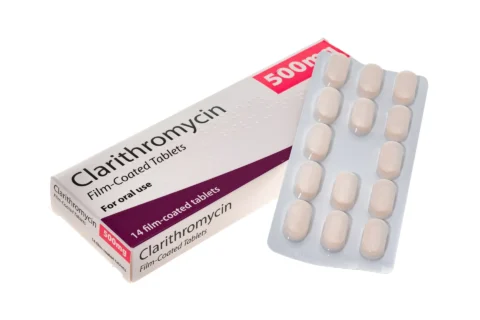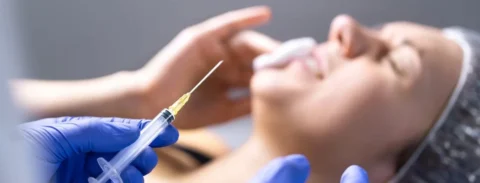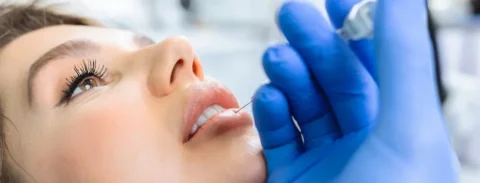For information only. Not meant as advice in any form. Please consult your medical professional or lawyer.
Computed tomography or CT scans and other imaging tests are necessary for surveying the current state of your body, with their ability to detect tumors, blood clots, infections, and even nodules. But some patients wonder if this test can differentiate dermal filler formations from the nodules in their skin. CT scans tend to have limited sensitivities, affecting the scanning, diagnosis, and treatment.
So can a CT scan detect the difference between dermal filler from nodules in the face? The quick answer is no, CT scans won’t produce conclusive results distinguishing dermal filler formations from nodules, even if it has detected the substance as calcification or soft tissue. Radiologists may have speculations about your test, but they will still recommend more sensitive tests, like MRI, for confirmation — dermal fillers may mask or mimic abnormal growths.
Can CT Scans Differentiate Dermal Fillers from Nodules?
CT scans are reliable imaging tests to provide your healthcare providers with a clear picture of your body. It allows them to see through the parts of your body undetectable to the naked eye. It scans the body to gather assessment relevant for diagnosing tumors, spotting internal bleeding, and visualizing other internal trauma or injury.
Since it involves providing images of your body with a collection of X-ray images, some patients wonder if it can also spot facial filler substances and differentiate them from nodules and other growths. This is especially when injectable filler treatments are becoming popular for facial rejuvenation and enhancements.
Cosmetic fillers can sometimes appear on CT scans as calcification, fluid, or soft tissue at the subcutaneous layer. Radiologists may even speculate that it’s a filler material based on its location, size, and amount. However, this image still won’t provide conclusive results; it wouldn’t confirm if the mass seen on the scans is an injectable facial filler, lymph nodule, foreign body granuloma, or other lesions.
Your radiologist might recommend having other imaging tests with enhanced sensitivity, like an MRI scan or magnetic resonance imaging. This allows your healthcare providers to see a clearer picture of the mass in your face and gather more information, which is crucial because dermal fillers tend to mimic abnormal tissues, inflammation, or infection.
A complex filler may also conceal a serious medical condition. Once they’ve verified if the mass is an injectable filler for facial wrinkles or a nodule, they’ll provide you with a more suitable diagnosis and treatment plan.
What to Expect from Your CT Scan
CT scans provide a reliable image of the state of your body by combining cross-sectional X scans. Facial filler substances are detectable on this imaging test, but their amount is too small to be caught sometimes.
They appear on the scans as clumps of calcification or soft tissues. It may mimic nodules and other abnormal growths, posing the risks of misdiagnosing as pathology. This brings the necessity for healthcare professionals to be informed of how cosmetic fillers and nodules look on imaging tests.
How Dermal Fillers Appear on CT Scans
A study has reported how cosmetic fillers will appear on CT scans. It has scanned patients who’ve had autologous fat fillers, hyaluronic acid filler injections, collagen fillers, poly-L-Lactic acid fillers, and silicone fillers.
1. Hyaluronic Acid Fillers
Hyaluronic acid filler of HA filler is the most common type of dermal filler, made with a synthetic material that mimics the body’s compounds. This type of injectable filler includes brands like JUVEDERM Ultra, Restylane Lyft, and more.
Hyaluronic acid filler has a fluid attenuation on CT, with an infiltrated appearance on the subcutaneous layer of fat. Radiologists can tell an HA filler formation apart from dermal and subdermal layers as this substance has approximately 600 ms T2 relaxation time.
2. Autologous Fat Fillers
Autologous fat filler treatment involves adding volume to your skin to reduce the appearance of facial wrinkles, like the nasolabial fold, laugh lines, and others. It’s a permanent filler because the volume may last for a lifetime if the fat has healthily attached itself to surrounding tissues. This injectable facial filler will show a low attenuation of soft tissue or fat density.
3. Collagen Fillers with PMMA Microspheres
Collagen filler is a type of injectable facial filler harvested from cows, pigs, and other sources with naturally occurring amino acids. Bovine and porcine collagens are FDA approved for facial rejuvenation. It’s also mixed in some cases with polymethylmethacrylate or PMMA microspheres and autologous collagen. Similar to hyaluronic acid filler, this filler material has a fluid appearance. The subcutaneous layer might also look infiltrated.
4. Calcium Hydroxylapatite Filler
Calcium hydroxylapatite, like the dermal filler brand Radiesse, is an FDA-approved treatment for facial wrinkles and fat loss. This serum has calcium hydroxylapatite microspheres suspended in a gel matrix made of methylcellulose. Calcium hydroxylapatite will have clumps or linear streaks on CT with high attenuation, ranging from 280 HU to 700 HU.
5. Poly-L-Lactic Acid Filler
Poly-L-lactic acid is a filler injection for treating facial fat loss, but it can also be used as an anti-wrinkle treatment and facial rejuvenation solution. This filler injection type is a biodegradable synthetic polymer derived from corn starch mixed with carboxymethylcellulose and mannitol.
Poly-L-lactic acid appears on CT as a foci attenuation of soft tissue, with collagen formation shown by strands of subcutaneous fat. This is because poly-L-lactic acid stimulates collagen production.
6. Silicone Filler
Silicone filler is a type of permanent filler for facial enhancements and acne scar treatment. This filler has a slightly higher attenuation or is similar to soft tissue on CT. Compared to other types of filler injection solutions, liquid silicone resulted in grave complications because of high doses of nonmedical grade silicone, poor injection technique, and underlying medical conditions.
How Nodules Appear on CT Scans
Nodules are abnormal tissue growths that may grow under the skin or any other body part. Generally called lumps if they’re at least 1 centimeter, these masses are usually benign, but they might also be indicative of an underlying medical condition.
Healthcare professionals will still determine the causes and types of your nodules once spotted, like enlarged lymph nodes, foreign body granuloma, or any other mass. CT scan is a reliable imaging test for observing nodules for an accurate diagnosis. However, a lump might have a similar appearance to filler material. It usually has an irregular opacity or a rounded form, around 3 cm in diameter. Some nodules look clear on CT, but some are also poorly defined.
What Imaging Test Is Recommended for Dermal Fillers VS. Nodules
CT scans can both detect filler material and nodules, be it a foreign body granuloma or an enlarged lymph node. However, it may not provide definitive details that may differentiate one from the other. Determining this is necessary for arriving at an accurate diagnosis and treatment, especially when dermal fillers may sometimes mimic malignant tumors. More than this, they may mask an underlying medical condition.
Expert radiologists recommend using magnetic resonance imaging or MRI scan for assessing a lump, dermal fillers, or filler-related complications because of its enhanced sensitivity, providing clearer images than a CT scan. It can provide a more detailed image of an area, even in larger scopes, because it visualizes the body with magnets and radio waves. It may also give you functional, quantitative, and anatomic information about the observed area.
How Dermal Fillers Appear on MRI
MRI scan is more recommended for differentiating dermal fillers from nodules or filler-related complications in the face as it provides a clearer image of the observed area. While CT scan may also detect these two formations, it may only give a general picture and not conclusive distinctions. Not having to determine what the lump is will be hard for you and your doctors to have an accurate diagnosis and treatment plan.
According to a study, here’s how some of the dermal filler types will appear on an MRI scan:
- Hyaluronic acid or HA filler – hyaluronic acid fillers, like JUVEDERM Ultra, have an appearance on MRI similar to water. You may also see in this imaging test the continuous diffusion of the filler and even its degradation. Your healthcare provider might also find less peripheral enhancement occasionally on the postcontrast images of sequencing with T1 weighting, lasting for about 2 months. Compared to other fillers, hyaluronic acid has fewer health risks and may be treated with hyaluronidase injections.
- Poly-L-lactic acid – Poly-L-lactic acid fillers, like Sculptra, have hypointense appearances on MRI with T2 weighted sequence.
- Autologous fat fillers – these types of fillers appear as fat signals on all MRI sequences. It may also have a thin pseudocapsule.
- Collagen fillers – collagen has high water content, so it will have a hypointense appearance on T1-weighted images, while they’ll appear hyperintense on T2-weighted and STIR images. There will also be fewer enhancements on the periphery 2 months after injection, though this does not necessarily mean there’s an infection.
- Silicone fillers – how silicone fillers will appear on MRI will differ according to purity and viscosity. Silicone oil fillers with a high viscosity have hypointense appearances on images with T2 weighting. Fillers with low viscosities are a bit hyperintense when in contact with water on T1-weighted images, but they will appear hypointense on T2-weighted scans and hyperintense on sequences involving “silicone-only” substances. This sequence aims to conceal other tissues and allow only silicone to show up.
- Calcium hydroxyapatite (CHA) fillers – these types of fillers would have a low signal intensity up to intermediate on images with T1 and T2 weighting. The calcified matrix from the fillers might also be vascularized, so a slight post-contrast enhancement might also appear.
How Nodules Appear on MRI
How nodules appear on the MRI scan depends on what type of nodule it is, either it’s a non-inflammatory nodule or a foreign body granuloma. These two differ according to histopathology and imaging. According to a study, foreign body granuloma is enhanced on MRI, but with varying degrees. These lesions will have a diffused enhancement or appear nodular.
How MRI Differentiates Dermal Fillers from Nodules
MRI scan is the best option for differentiating filler material from nodules or lumps. Because of its sophisticated sensibilities, it locates non-complicated and complicated dermal fillers in patients, even fillers only 2 mm in diameter. It can also spot granulomas and abscesses not seen in clinical examinations.
According to a study, MRI can differentiate facial fillers from nodules from the signature MRI features of each mass. However, some claims do not support this and maintain that differentiation still lies in the experience and training of the attending physicians.
Other Imaging Tests For Detecting Dermal Fillers and Other Complications
Choosing the most suitable imaging test is crucial for diagnosing a patient and determining if their mass is a lump or nodule or simply their dermal filler injections — filler material may mimic or mask abnormal growths. Some imaging tests, aside from CT and MRI scans, involve:
- Ultrasound – ultrasound is also a recommended imaging test for surveying facial fillers and superficial complications.
- PET CT Scan – a PET CT scan is more sensitive than a CT scan, but this is not recommended for scanning lumps and facial fillers because of its high FDG uptake that can mimic malignant tumors.
Visit FACE Med Store for Beauty and Medical Supplies for Dermal Fillers
CT scan can detect facial fillers and nodules, but it’s not sensitive enough to differentiate them. You’ll likely be prescribed to undergo sharper imaging tests, like MRI scans, to have more conclusive results. In some imaging tests, dermal fillers mimic abnormal growth or mask its appearance.
FACE Med Store is a trusted partner of many practices for delivering quality supplies for dermal filler and other medical and cosmetic treatments. Some nodules are caused by filler injections — investing in the right tools is key to avoiding complications, aside from choosing the right type of filler and having superior injection techniques. You may browse our catalog today to check out high-quality supplies at competitive prices.






